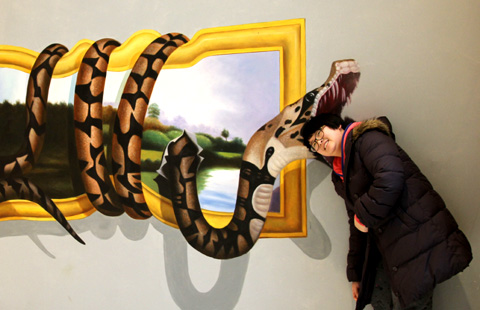
Museum's lowdown on the industry that goes into making an industry
On a road linking Hangzhou's famous West Lake and the mountains that surround it is a white and gray building said to be the largest silk museum in the world.
Anyone doing a thorough tour of the China National Silk Museum will leave with a wealth of knowledge about the history of silk in China and knowing how it spread to the rest of the world.
The museum, with exhibition space of 3,000 square meters, plays an important role in the city's plan to develop its silk industry.
Among the exhibits are silk worms that demonstrate how they produce their valuable product.
The Hangzhou city government says it spends 20 million yuan ($3.3 million; 2.4 million euros) a year to promote public knowledge of the city's silk industry. Funded programs include tours and transport that cover itineraries and destinations with the theme of silk, including the museum, the aim being to turn the city into a national draw card based on the fabric.
Zhao Feng, curator of the museum, says: "With thousands of years of history in China, silk deserves a museum to showcase its development to people, especially youngsters. But a museum alone is not enough to convey silk's fascinating story."
Apart from exhibitions, the museum presents lectures and handcraft activities that are open to all. But for young visitors in particular it is the silk worms that are the star attraction.
"For children, the best way to learn is to look, touch and try," Zhao says. "Historical accounts and cultural relics are important too, but these are often too dull for children."
The hands-on approach at the museum is emphasized by weaving machines that visitors can operate.
One enthusiastic visitor to the museum recently was Ruan Jinyou, 10, a third-grader at Hangzhou Xingzhi Elementary School, who said she loves the place.
"I like silk worms, but mum won't let me to keep them at home. I came here every week over the summer holidays to watch what they do."
She can now explain silkworms' lifecycles and habits in detail, and her mother, Xu Mengsha, says she is glad the museum is there to satisfy her daughter's curiosity.
Among other displays in the museum are the latest in clothing made of silk.
The museum has different themes every three months that emphasize different aspects of silk, Zhao says.
"Last season it was the qipao, a traditional Chinese women's garment. That exhibition attracted a lot of foreigners because it was something they did not know anything about."
The museum will seek to work with other institutions overseas so more people can learn about Chinese silk, he says.
"Even though the silk industry has its roots in China, most people only know silk products made by European countries like France and Italy. For Chinese silk, that is unfair. I hope the museum can play a role in more people becoming aware of the industry's role in China."
yanyiqi@chinadaily.com.cn
|
Children learn about silk at the China National Silk Museum in Hangzhou. Yan Yiqi / China Daily |
(China Daily Africa Weekly 02/14/2014 page16)








